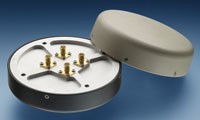TE Connectivity, a world leader in connectivity, and a leading supplier of standard and custom antennas for consumer applications, is bringing its expertise to military and aerospace markets in the form of moldable composites and selective metallization. TE is delivering antennas that are smaller and lighter, and offer higher performance and increased functionality in flight and ground applications.
Advancements in materials science are enabling next-generation technologies like low-profile conformal antennas and antennas integrated into housings that help reduce complexity, simplify manufacturing and provide consistent performance.
“TE is continually working to improve antenna technology through advancements in materials science to help lower cost, weight and size,” said Kathleen Fasenfest, senior electrical engineer of antenna products, Global Aerospace, Defense & Marine, TE. “Fiber-filled composites will be instrumental in creating lower profile antennas because they are stronger than the unfilled plastics often used in today’s technology and even allow for thinner radomes.”
Recent advances in long and continuous glass fiber composites reduce the need for tedious and costly hand layups of traditional radome manufacturing, while enabling the creation of stronger, thinner and lighter radomes. Composite enclosures can be 30 to 40 percent lighter than the aluminum enclosures they replace.
TE’s consumer antenna heritage also brings reliable solutions for dramatically reducing weight by integrating some circuit board traces, wires and connectors for fewer overall components. For example, TE’s 3D selective metallization process can be applied to a wide range of substrates including plastics, chemically resistant composites, glass, ceramic and metals to reduce weight. The metallization is extremely durable and withstands shock, vibration, fluids and salt spray to the levels typically required for aerospace applications. This process enables rapid development and manufacturing of robust 3D antennas for harsh environments.
Conductive inks and coatings are key tools in lowering size, weight and power (SWaP) because they allow developers to replace metal components with coated plastic or composite parts. Conductive coatings also offer the possibility of printing antennas directly on structural composite parts such as body panels, enabling excellent integration of antennas into vehicles and other platforms.
For more information on TE’s antenna capabilities, contact the Product Information Center at 1-800-522-6752 or visit www.TE.com
